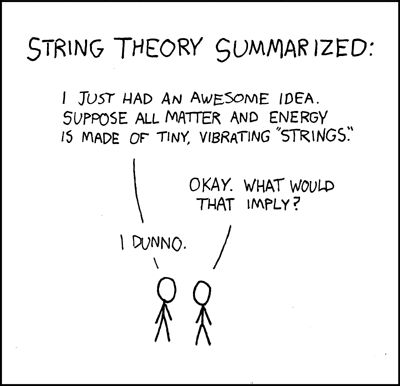Posted on 06/01/2009 7:09:36 PM PDT by SunkenCiv
(Excerpt) Read more at newscientist.com ...
Why cats fail to grasp string theoryNow we know why cats never get bored of chasing string. A new study has found that domestic felines don't seem to understand cause and effect connections between objects.
by Ewen Callaway
Journal reference: Animal Cognition
Chimpanzees, tamarin monkeys, parrots and ravens all understand that tugging on one end of a string will bring a treat at the other end closer. Pigeons and human infants don't; and cat lovers dismayed at their pets' lack of nous can console themselves with the knowledge that dogs don't either.
"There's no reason to think that cats are more stupid than dogs," says Britta Osthaus, a comparative psychologist at Canterbury Christ Church University, UK, who led the study. "I've done quite a few tests and I always find that dogs just don't get it."
Working with 15 shelter cats, Osthaus's team attached fish or biscuit treats to one end of a string. A plastic screen with a small gap at the bottom separated cats from their reward, requiring the felines to tug on the string to get the treat.
With a single string attached to the food, most cats learned to paw at the string to get a snack. But when Osthaus' team introduced a second piece of string, unconnected to any foods, cats tugged on the correct string less than half the time.
This suggests that the cats couldn't infer cause-and-effect relationships between two objects and could only learn an association from scratch each time.

· Google ·
So... has string theory ever predicted any experimental results?
Has there been a bigger failure in the history of modern physics? Nope.

You want the Theory of everything Call my Father in Law
I don't follow the string theory goings-on, but I doubt it. Its always struck me as seeming like they just make up a bunch of crazy stuff, most likely after passing a joint around.
Then again, trigonometry seemed that way to me too.
It has, but there’s no way (at present) to carry out the experiments. Check the “stringtheory” keyword (above) and search for “Large Hadron Collider” in that topic list. There’s at least one experiment which will (further) refine, well, let me do it... no, let me use Google... okay, I’m going to be now, but this is probably good:
String fellows - [interview with string theorist Edward Witten]
Education Guardian (U.K.) | January 20, 2005 | Alok Jha
Posted on 01/21/2005 8:07:28 AM PST by snarks_when_bored
http://www.freerepublic.com/focus/news/1325427/posts
Thanks! There’s a post about the book in the FR ‘blog topic “String Theory” (it’s linked up there in the ping message), and I thought I’d posted a review as well; Woit has a ‘blog out there somewhere.
I used to have “Silly String Theory” graphics, must be the wrong hat.
This is a solid development for some knotty problems...
Woit's blog is: Not Even Wrong, if you're interested.
Bookmark

I’d been swimming in a luxurious, long, deep pool in the San Fernando Valley at. 83° by a thermometer in the water while 100°+ in the air.
Sitting in the Sun, feet dangling in the water, I could see the light’s refracted patterns (Snell’s law) from it’s surface along the bottom of the pool.
I’d seen video documentary mock-ups to show how existence “looks” at or near the Planck Scale.
Yet here and now was an example even clearer.
Envisioning part of the pool bottom as a slice of “quantum space, filaments fleeted into - and out of - existence, each having been created by that gone before. And out of them bits of brightness, (again, reflections of the Sun along the surface, cast on the bottom and sides) would move along the length of each segment, intersecting with their ends...such “strings” quickly dissipating here, and reappearing there with each such interaction.
Moreover, there would enter waves of interference (by admittedly moving my legs) that would yield to the “strings” an even greater sense of overall excitation.
In a stretch, this might be seen as a representation of the “Uncertainty Principle” where at the quantum level, “virtual” entities come into and go out of existence, yet perhaps summing to an “actualization” of reality, which however even billions of years hence, may as likely decay and zap back into the void from whence they came.
And I’d bet too that this could all be worked out mathematically.
But, as I said, it’s merely a representation of such conditions, which is all that can ever be achieved at the Planck Scale anyway.
So, as this lazy day’s imaginings gave rise to other waxings, into the water I went, even in that second of submergence, to childhood again.
Disclaimer: Opinions posted on Free Republic are those of the individual posters and do not necessarily represent the opinion of Free Republic or its management. All materials posted herein are protected by copyright law and the exemption for fair use of copyrighted works.